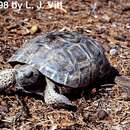pt-BR
nomes no trilho de navegação


Tortoises are known in legend and folklore for their leisurely ways and slow pace. The Florida gopher tortoise follows this legend well with a slow pace of between .27 and .5 miles per hour.
The gopher tortoise has a vital community role and is known as a keystone species because of the wide use of their burrows by other animals (such as burrowing owls, raccoons, opossums, gopher frogs, snakes, etc.). Because they are a keystone species, the protection of the gopher tortoise is crucial for the whole ecosystem in which it lives. In some states the gopher tortoise is being protected by state agencies that are enforcing conservation laws and controlling illegal harvest. Besides protecting the tortoise against poaching other methods of conservation are being used. Relocation of gopher tortoises has been used, with success, to protect tortoises on land that is being developed. Reintroduction into areas from which the tortoises were driven has also been used. Protection of gopher tortoise habitat, such as sand dunes and longleaf pine forests, is also an alternative that can help keep populations high.
IUCN Red List of Threatened Species: vulnerable
There are few negative aspects of the gopher tortoise. The occasional damage of crops by hungry tortoises and the relocation costs of developers needing to relocate tortoises from areas being built are the only negative aspects.
Ancient Indians had a monetary system that used gopher tortoises in the place of money. Shells of the tortoises have served as baskets, pots and even sun helmets. Even today, they are a source of food for poorer rural people of Florida and south Georgia.
Overall, the gopher tortoise is an herbivore that enjoys low vegetation. The gopher tortoise spends most of its foraging time grazing in areas with a good supply of grasses and low herbs. Its food primarily consists of grasses and leaves with the occasional wild fruits and berries. In captivity gopher tortoises have been known to be fond of watermelon and cantaloupe rinds.
The gopher tortoise is found in the southeastern part of the United States. Its range includes southwestern South Carolina, south almost to the tip of the Florida peninsula; west through southern Georgia, Alabama, and Mississippi, to Louisiana and the edge of southeastern Texas and Arkansas
Biogeographic Regions: nearctic (Native )
The habitat of the gopher tortoise is in sandy ridge and sand dune areas where the water table never comes near the surface. The forests of longleaf pine, Pinus palustris, are also prime areas for gopher tortoise habitation.
Habitat Regions: temperate ; terrestrial
Terrestrial Biomes: desert or dune ; savanna or grassland ; forest
Adult gopher tortoises require 16-21 years to mature, and can live 40 years or longer.
Average lifespan
Status: captivity: 8.5 years.
The upper shell is brown or tan, with growth rings evident on younger individuals, but these are worn away on adults. The under shell is unhinged, dull yellowish in color, with the soft parts being grayish brown. The upper shell can range in length from 107 mm to 240 mm. The feet of this tortoise are stumpy and without webs, and their heads are large and blunt. Compared to the other species in the genus Gopherus, the gopher tortoise's head is broad, hind feet small, and shell elongate.
Range length: 170 to 240 mm.
Other Physical Features: ectothermic ; heterothermic ; bilateral symmetry
Average mass: 5500 g.
Average basal metabolic rate: 0.579 W.
The mating behavior of the gopher tortoise is not well documented because of its secretive nature. Male gopher tortoises have been known to utter short rasping calls, to attract females. Fights between male and female gopher tortoises are also sometime seen, which could be related to courtship and mating. Males have a pair of glands under their chin that may function to attract females. The eggs of the gopher tortoise are laid in late April to July. They are deposited, five or six eggs at a time, in holes dug in the ground so that they are protected from the blazing sun. Once in the nest cavity the eggs incubate for approximately 100 days.
Breeding interval: Gopher tortoises breed once per year.
Breeding season: April through July
Key Reproductive Features: iteroparous ; seasonal breeding ; gonochoric/gonochoristic/dioecious (sexes separate); sexual ; oviparous
Average gestation period: 90 days.
Average number of offspring: 8.
Average age at sexual or reproductive maturity (male)
Sex: male: 3650 days.
Average age at sexual or reproductive maturity (female)
Sex: female: 3650 days.